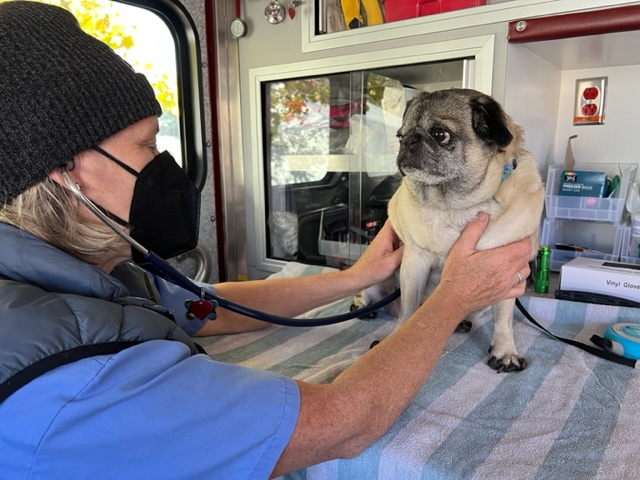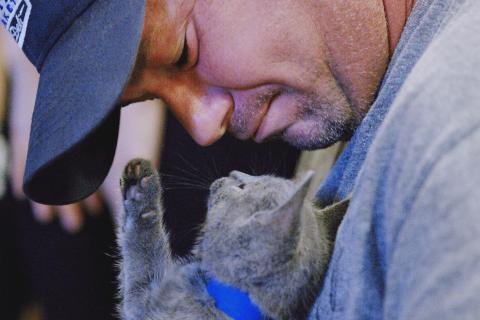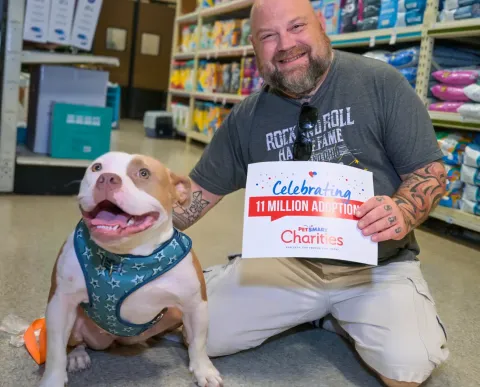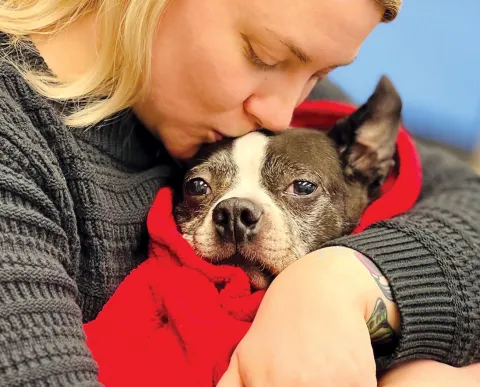As the top funder of animal welfare in the U.S., we have a responsibility to lead the charge in identifying and responding to widespread trends and problems. PetSmart Charities is calling on partners and stakeholders like you to create solutions — because we’ve reached a tipping point. We need your help, and we want to invest in your efforts, too with this significant commitment.
As we all know, when pets don’t receive adequate care, they suffer — and their families do, too. When not addressed, small and preventable problems become bigger and more costly. A lack of veterinary care means preventable diseases can be passed on to people and other animals. Many loving pet parents are then forced to relinquish their pets, taxing an already overcrowded shelter system. It’s an impossible choice to make, given that people from all walks of life benefit from caring for these important family members that love us like no other.
We must do better, and together, we will. The animal welfare community over the last decade has made serious progress in saving significantly more animals through adoption. Today, pets are included in 70% (or 90 million) of American households[1]. Now, we need to ensure pets can stay in their loving homes — in the best health possible.
How did we get here? A variety of barriers have converged, including:
A shortage in veterinarians: With pet ownership steadily on the rise (good news!), a 33%[1] increase in pet healthcare service spending is expected over the next 10 years. 90 million U.S. households now include pets, but the number of nationwide veterinarians (now at just over 121,000) has increased by just 2.7 percent each year since 2007. To meet the growing need for veterinary care, an additional 41,000 veterinarians would be needed by 2030.[2]
Veterinary deserts: For rural and underserved regions especially, veterinary practices usually aren’t conveniently located; plus, transportation and other cultural barriers shut pet parents out of services.[3]
Rising cost of veterinary services: A payment-on-demand service system makes it impossible for many to afford care; and vet care costs have spiked 10% in the last year. 63% of pet parents say inflation[4] has made it more difficult to pay for surprise vet bills, and a $499 vet bill would put 28% of pet parents into debt.[5]
Racial equity and cultural inclusion: Veterinarians are among the top five least diverse professions, leading to cultural and often language divides between clients and practitioners, along with fewer clinics sited in communities where minorities are already impacted by systemic inequalities.[6]
Economic challenges: A spike in inflation combined with a housing market crisis and the impacts of the pandemic hit the lowest income groups the worst; 29 million pets live in households that depend on SNAP benefits.[7] The impact of these varied influences means veterinary cost is out of reach for many families, even in households with median income levels.
As you can see, a myriad of influences has converged to create a tipping point. We’re up to the challenge; are you?
PetSmart Charities Commits
No single solution or organization can solve this complex issue; we need all-hands-on-deck. PetSmart Charities has committed $100 million over the next five years and will take a multi-faceted approach by funding a variety of solutions to improve access to adequate veterinary care for all pets.
First, we will help build solutions across the system of veterinary care – from funding new and more affordable types of clinics to addressing the specific needs within diverse and underserved communities. In 2022, we and our friends at PetSmart brought low-cost clinics into select stores. These clinics, along with our “Accelerator” grant program that fuels low-cost clinics to expand, will help us share best practices and encourage others to join us in ensuring affordable veterinary care is accessible to those who need it.
Next, we’ll support options to help pet parents better afford care as inflation continues to take a toll. This involves developing innovative solutions that reduce and help manage the cost of care for all, including telehealth care models, deferred payment plans, as well as supporting on going, data driven, research on more cost-effective ways to treat common ailments.
It’s also critical that we build alliances with the veterinary educational system. Significant plans are currently underway, including naming an endowed chair at a top university to conduct research around evolving trends and needs. We’ll continue to award scholarships to veterinary students pursuing community-based practices, while also working with veterinary universities to establish a Master’s level training program for midlevel veterinary practitioners to offer basic care at affordable prices. We want to do our part to bolster and support the noble veterinary profession and encourage their community to also make contributions to solving this problem.
Finally, we’ll tackle an issue so many of us are invested in — ensuring that the animal welfare space is one that welcomes, equips and includes a broad spectrum of leaders. In diverse, or in underserved communities, people often trust and connect best with their friends, neighbors and local leaders. Supporting and encouraging changemakers to develop unique solutions with an emphasis on meeting the specific needs of their community is key to integrating more options for veterinary care. It’s what we call our “Incubator” grant portfolio, and the first cohort of recipients in Latino communities is already underway. We’ll be sharing more of those journeys with you in the months to come as our grantees build community and capacity for grassroots efforts around opening access to veterinary care where it’s urgently needed.
We hope you’ll take time to learn more about how you, too, can join our coalition. Please message me via Linkedin to connect and learn more. If you’re not already on our email list, please sign up here to receive updates on grant opportunities and other news. Together, we can help pets, and the people they love, thrive!
[1] (American Pet Products Assn., 2021)
[2] https://www.marsveterinary.com/tackling-the-veterinary-professional-shortage/
[3] https://www.dvm360.com/view/study-reveals-presence-of-veterinary-deserts-in-low-income-areas
[4] https://apnews.com/article/inflation-health-economy-prices-pets-5e6ab45eb6e3e316a89158bb630a9835
[5] https://www.forbes.com/advisor/pet-insurance/pet-cost-inflation/
[6] https://cctsi.cuanschutz.edu/docs/librariesprovider28/cctsi-summit/2022/presentations/14-geller-structural-racism-in-veterinary-medicine.pdf?sfvrsn=688575bb_4
[7] https://pphe.utk.edu/wp-content/uploads/2020/09/avcc-report.pdf











